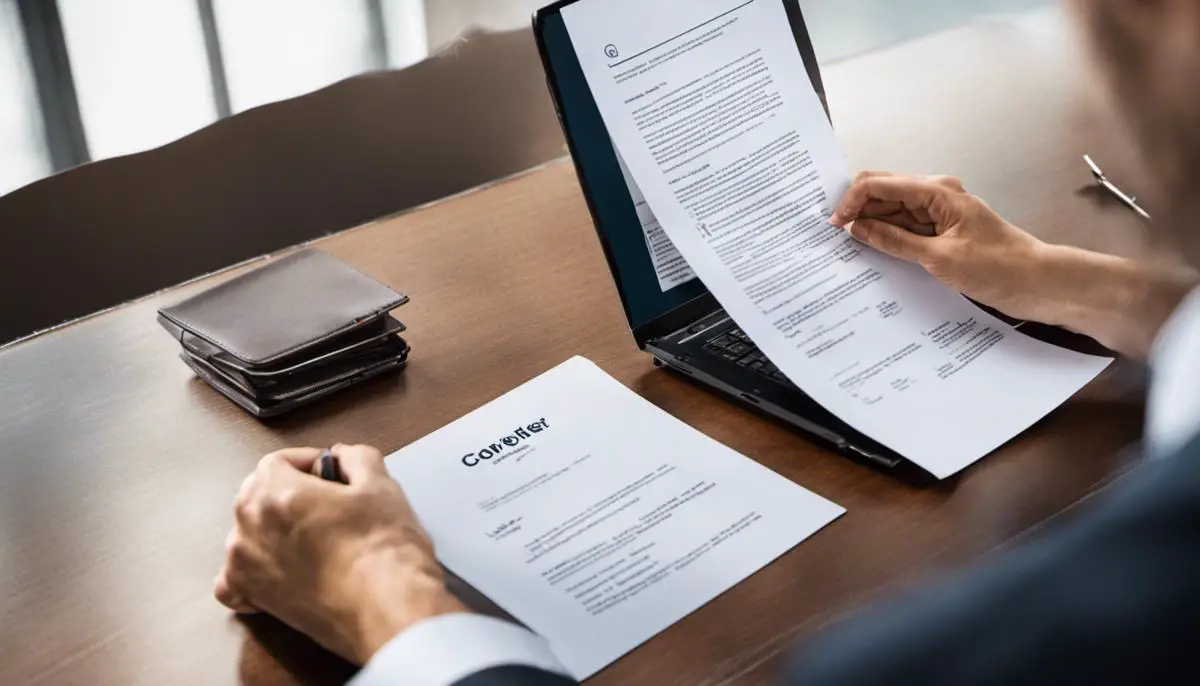Unlocking the potential of a compelling cover letter may be your key to landing the job you’ve always desired. This essential tool does more than supplement your resume—it gives the employer a glimpse at your personality, communication skills and eagerness for the role.
A cover letter, if crafted well, tells your unique story and underscores your suitability for the job. The importance of a well edited cover letter might make the difference for you to get that dream job. To achieve this, every aspect, from the header to the signature, needs meticulous attention. But, what does a captivating cover letter look like and what do employers look out for?
Guided by an understanding of what the recruiter seeks, which is often an insight into who you are beyond your resume and your ability to perform the job excellently, you can craft each part of your cover letter to echo these expectations. This highlighted understanding networks with the proofreading and editing skills you must possess to ensure a cover letter free of errors, consistent in flow of information and presenting a succinct message.
Understanding the Purpose of a Cover Letter
Stand out, make an impression – that’s the primary ethos of a winning cover letter. In a world teeming with ambitious talents, your cover letter is your knight in shining armor, pouncing forth from the dunes of generic resumes. It’s the marquee of your professional theatre, the ensign of your career flotilla. But why does it matter so much, and what role does it play in the business world’s dynamic job application process? Let’s take a delve into the heart of this purposeful document.
A cover letter primarily serves one central purpose – to provide a compelling narrative of who you are. It’s not an array of bullet points or a chronological list of past positions held; it’s a compelling story, an engaging pitch, and an exhibition of your personality.
Beyond the sheets of certificates, beyond the tidal wave of degrees and accolades, recruiters yearn to see a human touch, an individual. They seek the answer to one pivotal question – who are you, really? Your cover letter gifts them this revelation amidst an engaging narrative.
A diligent professional knows every potential employer has unique requirements. The cover letter symbolizes your ability to meet these specific needs, connecting the dots between what you bring to the table and what the firm hungers for. It’s a platform where you showcase your comprehensive understanding of the role, industry, and the company’s culture. The cover letter is where you demonstrate that you’ve done your research and are ready to dive headfirst into the new opportunity, armed with pervading knowledge and relevant skills.
Additionally, the cover letter serves as a testament to your communication proficiency. It’s your resume brought to life, infused with warmth, vibrancy, and a tinge of authenticity. Eloquently written, it attests to you masterfully wielding one of the most crucial and desired soft skills in the modern business world – effective communication.
However, let’s refrain from embracing naivety. Even skilled professionals are prone to err. Always remember to tailor your cover letter to each job application. Negative outcomes like redundancy or repetition can shroud your efforts and put off recruiters. Instead, focus on quality, relevance, and personalization.
Employ this nimble tool as an opportunity to transcend conventional boundaries and limited job descriptions. Do remember to maintain a fine balance between being assertively persuasive and excessively presumptuous. Honesty, blended with a touch of humility and a generous dash of confidence, make the perfect mix.
In essence, the cover letter is your professional handshake—an invitation to potential employers to embark on the journey of knowing you better and tapping into what you offer. As the competition intensifies, only those who present and promote themselves effectively stand victorious on the battleground of job applications.
The purpose of a cover letter? Why, it just might be the key to unlocking the unyielding doors of your dream job. The question is, are you ready to turn that key?

Identifying Essential Components of a Cover Letter
Diving right into it, the cover letter’s primary role is to serve as an introductory tool designed to grab the attention of potential employers and, in turn, prompt them to review your resume in depth. To ensure that your cover letter is effective, several vital components should be meticulously incorporated.
Firstly, A robust header is paramount. This seemingly insignificant segment of your cover letter can significantly influence an employer’s first impression. The header should contain your contact information and the potential employer’s. Brush off the urge to utilize flashy fonts or images; instead, opt for a straightforward and professional approach.
Secondly, an engaging opener is vital. The introduction should succinctly explain why you are reaching out to this particular company and what job position you aspire to fill. Highlight a bit about your background, but remember your resume exists to delve into that. Your cover letter’s opening paragraph should pique a hiring manager’s interest and convince them to continue reading.
The next essential component is a body that showcases your hard skills. Delineating your hard skills, meaning the technical abilities you possess that directly relate to the job, is critical. While it is instrumental to align these skills with the job description, innovatively bringing forward how you applied these skills in previous roles to drive performance will leave a lasting impression.
Following this, your cover letter should spotlight your soft skills or interpersonal abilities. These can include problem-solving, interpersonal communication, creativity, adaptability, and leadership. The harmony of hard and soft skills could be the distinguishing factor between you and other candidates with similar qualifications.
Then comes the section where you elucidate your compatibility with the company’s goals and mission. This isn’t about merely regurgitating the firm’s mission statement. Rather, it’s about offering concrete examples of how your values, experiences, or aspirations line up with those of the company. Interweaving such a narrative demonstrates not just your knowledge about the company or industry, but your long-term commitment and cultural fit as well.
To cap it off, a compelling close that cinches the deal is key. Much like a sales pitch, a decisive closer reaffirms your interest in the job and subtly nudges the employer into action. While remaining professional, articulate your eagerness to further discuss your qualifications in an interview setting.
It’s worth stressing that, while incorporating these key components can help craft an effective cover letter, proofreading to eliminate any spelling or grammatical errors is equally important. A cover letter represents your professional acumen; any missteps might cost you a great opportunity.
Ultimately, a well-crafted cover letter is more than a mundane, obligatory document attached to your resume. It’s an instrument that, if well-played, can brilliantly highlight your candidacy, leaving employers intrigued and excited to learn more about their potential new hire. Harness the power of a well-written cover letter, and you might just ignite a remarkable transformation in your professional journey.

Developing Editing and Proofreading Skills
By now it should be clear that a cover letter is more than just a professional introduction. It’s a critical component of the job application process, serving as a narrative platform to showcase an applicant’s competence and fit for a specific role in a company. That said, let’s touch upon some necessary editing and proofreading steps to optimize the process of creating a cover letter that shines.
First things first, each line in your cover letter needs to serve a purpose. Assess each sentence critically and ask yourself, “What does this sentence communicate? Why is it important?” Avoid “fluff” or unnecessary elaborations that don’t add value. Your goal when editing and proofreading is to ensure you’re saying much, with less. Remember, effective communication is succinct and purposeful.
Secondly, rigorous proofreading entails being watchful of grammatical accurate and consistency in tense and voice. Software tools such as Grammarly and ProWritingAid can offer assistance, but the human eye is indispensable in context-sensitivity and tone. Editing software won’t catch if you’ve used a technical term inappropriately or mismatched your tone to the company’s culture, you need to re-read the text for context and appropriateness.
Thirdly, ensure your cover letter is void of typographical errors and misspellings. They are more than just blunders, they signal negligence and lack of attention to detail– traits not well received in any professional setting. Running your cover letter through spelling and grammar checks is essential but, don’t lean on them solely– manually combing through is still highly recommendable.
Furthermore, engage a trusted friend or professional contact to give your cover letter a glance. An external perspective is priceless, for it spots things you might have become blind to, and can comment objectively on the effect and persuasiveness of your writing.
Lastly, a common mistake is to leave gaps between your skills and experiences, and the requirements of a job. Fill in these gaps by judiciously peppering your cover letter with keywords culled from the job description.
Ultimately, editing and proofreading is not just about getting rid of errors, but also enhancing readability and impact. A polished cover letter stands high chances of not just securing a job interview, but also winning respect even before you walk into the interview room. Editing and proofreading is thus a mandate, not an option. It positions you as a careful professional, who takes their time to get things right. This leaves an impression– one that can only redound to your advantage.

The art of editing and proofreading is a skill developed over time. A well-edited cover letter displays a commitment to excellence and attention to detail, two qualities every employer appreciates. Whether you use editing tools or proofread manually, the goal is to submit a letter that reflects your best qualities neatly packaged in a compelling, error-free narrative. Remember, your cover letter should grab attention, maintain interest, and above all, leave the recruiter with an indelible impression that you are the perfect fit for the job. Therefore, a commitment to continually improving your editing skills is not an option, it’s a necessity.
When you submit that job application, you want to be confident that your cover letter has effectively showcased who you are, highlighted your skills and experiences, and most importantly, argued convincingly for your match with the job. Combining understanding of the purpose and essential components of the cover letter with a sturdy grasp on editing and proofreading skills will ensure you emerge as a worthy candidate. Now armed with these valuable insights, you are ready to create cover letters that captivate, engage and impress any recruiter.
